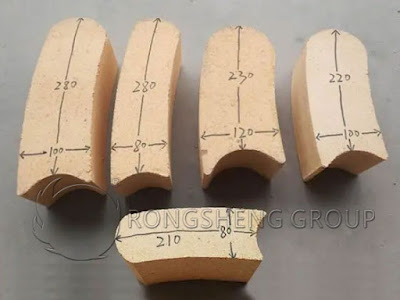When the ladle is used for the first time, all parts of the ladle must be thoroughly inspected. Parts such as gantry hooks, various protective devices, and safety forks should be inspected in particular detail. If damage is found, it should be replaced in time. The steel ladle must be inspected with 2 times the load during initial use.
 |
| Precautions for Using Ladles |
Precautions Before Using the Ladle
Repair of ladle lining. Refractory materials, including refractory bricks, refractory mortar, and refractory mud, should be appropriately selected according to the type of molten steel. For example, ordinary carbon steel uses silicon refractory materials; ordinary alloy steel uses aluminum refractory materials; manganese steel uses magnesium refractory materials.
When using a plug-rod ladle, the ladle nozzle and refractory layer must be constructed in the following order.
(1) Install the sprue brick at the nozzle at the bottom of the package. The sprue brick should be paired with the plug brick and ground before installation.
(2) Install the seat brick.
(3) Use refractory bricks to build the bottom and walls of the ladle. The bottom part of the bag should be sloped 1/20 towards the water outlet. For the used package body, if the corrosion of the refractory layer is not large, you can only replace the refractory bricks at the nozzle and repair part of the refractory layer.
 |
| Refractory Bricks for Steel Ladle |
(4) Before using the plug rod, the resistant material must be constructed in the following order. Insert the stopper rod through the ground stopper brick and secure it in place. Place the sleeve brick on the plug rod, and fill the space between the sleeve brick hole and the plug rod with dry fine sand or asbestos powder. The contact surfaces of plug head bricks and sleeve bricks should be coated with refractory mud. Add a pressure cap to the end of the sleeve brick, and use a nut to tighten the sleeve brick through the gland.
Installation of sliding spouts. First, install the sliding nozzle well bricks, and then build the refractory material according to the specified thickness of the refractory material.
Ladle baking
Install the plug rod filled with refractory material on the cross arm. During installation, the concentricity of the plug brick and the sprue brick must be adjusted to ensure sealing. After the adjustment is completed, use nuts to reliably fix the plug rod and the transverse hip.
After assembly, the newly repaired refractory ladle should be thoroughly baked 6 hours before use. The baking temperature should be gradually increased from low to high (800℃, constant temperature for 1 hour).
Lower the hanger while the ladle is baking. The drying bag can be used with gas or natural gas. The baking time of used ladles can be shortened. However, the baking time should not be less than 2 hours, and the baking temperature should not be lower than 800℃.
Precautions for Casting Use
1. Before casting, first check whether the safety fork is reliable.
2. Align the pouring opening of the pouring ladle with the opening of the pouring cup of the mold.
3. Before pouring, use the lever to press the plug rod and loosen the locking bolt at the same time to make the pouring ladle in the poured state. When pouring, slowly lift the plug rod, and the molten metal will flow out from the bottom nozzle. The greater the lifting distance of the stopper rod, the greater the flow rate of molten metal. Therefore, the pouring speed can be controlled using a lever.
4. After pouring, check whether the sprue bricks, plug bricks, and sleeve bricks at the nozzle are severely corroded, cracked, or otherwise damaged. If it is damaged, it should be replaced. If it is not damaged, the adhered metal residue or other adherents should be cleaned and maintained for use. Under normal circumstances, the sprue bricks, plug bricks, and sleeve bricks need to be replaced after one package of molten steel.
5. When using the sliding nozzle ladle, pay attention to the drainage sand in the nozzle. When pouring a casting, first open the sliding nozzle mechanism to release a portion of the molten steel (release the drainage sand). Prevent the drainage sand from rushing into the casting and affecting the quality of the casting.
After the ladle is used, the bad refractory materials should be removed and the refractory materials should be rebuilt. At the same time, inspect the pouring ladle, including hoists, lifting rings, beams, safety devices, stopper rods stopper rod driving devices, and sliding nozzle devices.






没有评论:
发表评论